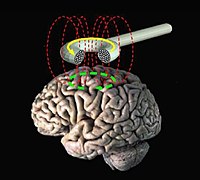
Photo from wikipedia
BACKGROUND Repetitive transcranial magnetic stimulation (rTMS) is able to modify cortical excitability. Rat rTMS studies revealed a modulation of inhibitory systems, in particular that of the parvalbumin-expressing (PV+) interneurons, when… Click to show full abstract
BACKGROUND Repetitive transcranial magnetic stimulation (rTMS) is able to modify cortical excitability. Rat rTMS studies revealed a modulation of inhibitory systems, in particular that of the parvalbumin-expressing (PV+) interneurons, when using intermittent theta-burst stimulation (iTBS). OBJECTIVE The potential disinhibitory action of iTBS raises the questions of how neocortical circuits stabilize excitatory-inhibitory balance within a physiological range. Neuropeptide Y (NPY) appears to be one candidate. METHODS Analysis of cortical expression of PV, NPY and vesicular glutamate transporter type 1 (vGluT1) by immunohistochemical means at the level of cell counts, mean neuropil expression and single cell pre-/postsynaptic expression, with and without intraventricular NPY-injection. RESULTS Our results show that iTBS not only reduced the number of neurons with high-PV expression in a dose-dependent fashion, but also increased the cortical expression of NPY, discussed to reduce glutamatergic transmission, and this was further associated with a reduced vGluT1 expression, an indicator of glutamateric presynaptic activity. Interneurons showing a low-PV expression exhibit less presynaptic vGluT1 expression compared to those with a high-PV expression. Intraventricular application of NPY prior to iTBS prevented the iTBS-induced reduction in the number of high-PV neurons, the reduction in tissue vGluT1 level and that presynaptic to high-PV cells. CONCLUSIONS We conclude that NPY, possibly via a global but also slow homeostatic control of glutamatergic transmission, modulates the strength and direction of the iTBS effects, likely preventing pathological imbalance of excitatory and inhibitory cortical activity but still allowing enough disinhibition beneficial for plastic changes as during learning.
Journal Title: Brain stimulation
Year Published: 2018
Link to full text (if available)
Share on Social Media: Sign Up to like & get
recommendations!